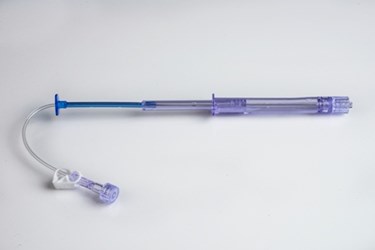Needle-Free Blood Draw Device Receives Additional FDA Clearance

Velano Vascular, a San Francisco-based medtech start-up, announced that the FDA has cleared an updated version of its needle-free blood draw technology. Since the device’s initial clearance last year, the company has collected patient and caregiver feedback regarding its usability, and its developers hope to establish the technology as the standard of care for inpatient blood draws.
Velano Vascular estimates that U.S. hospitals perform more than 300 million blood draws per year, and patients who are hospitalized often require several blood draws per day, which can be painful for the patient and dangerous for their caregivers, who are at risk for needle-stick injuries. Velano Vascular’s novel technology hooks into peripheral intravenous (PIV) catheters, temporarily repurposing them to draw blood into a vacuum tube or syringe. According to developers, the single-use device can be used without disturbing or even waking the patient.
“The FDA’s clearance of this novel technology validates the existing clinical need and will allow us to expedite our efforts to bring this innovation to patients, healthcare providers, and hospitals around the world,” said Velano Vascular co-founder and CEO Eric Stone in a press release last year.
Since last February, Velano Vascular has made two modifications to the device — based on user feedback — that enhance its usability and refine its indication for use (IFU). The updated device comes with a clamp to improve syringe draws, which are common with pediatric patients. While the earlier clearance stipulated when the device could be used with PIV catheters, the most recent approval removed that limitation.
“We rapidly implemented and pursued FDA clearance for these modifications based on input from patients and medical professionals who are using and systematically assessing our blood draw technology,” said Stone in a recent press release.
Velano Vascular currently partners with several hospitals and nonprofits, including Brigham and Women’s Hospital, U. of Penn’s Health System, Children’s Hospital of Philadelphia, and Children’s National Hospital to collect real-world input on blood draw procedures and the alternative technology. The company hopes to leverage the data it has collected from these health systems into broader commercialization of the product.
According to Stone, the key will be convincing hospitals the device’s efficacy and overall value. “There are 30 different economic inputs to today’s blood draw procedures, from materials and labor to the indirect or intangibles like patient experience, practitioner workplace anxiety, safety, delays in diagnosis, or the costs and risk of blood draws of a central line,” said Stone, remarking that a 75-cent needle could eventually cost the hospital between $30 and $40 when additional factors were taken into consideration.
Recent shifts towards value-based care and at-home treatments have sparked significant development in needle-free technology for everything from biologic injections to glucose monitoring to blood draws.
Wisconsin-based start-up Tasso recently introduced Hemolink, a platform that uses suction to withdraw a small blood sample. The device — which was partially funded by Defense Advanced Research Projects Agency (DARPA) — can be self-administered at home and potentially sent to through the mail to a lab for analysis.
Recently filed patents indicate that Verily (formerly Google Life Sciences) is also working on a needle-free blood draw device.
